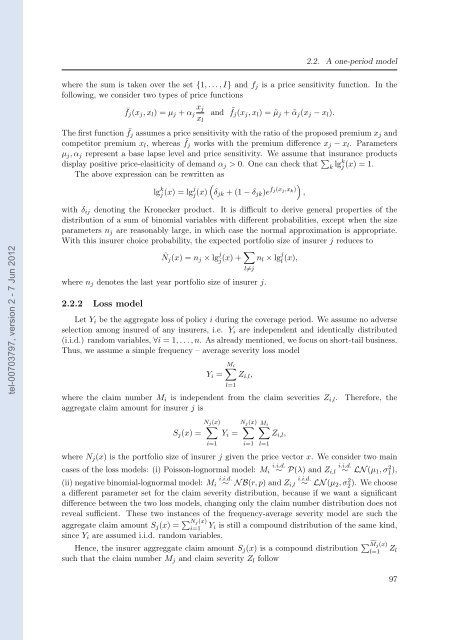Etude des marchés d'assurance non-vie à l'aide d'équilibres de ...
Etude des marchés d'assurance non-vie à l'aide d'équilibres de ...
Etude des marchés d'assurance non-vie à l'aide d'équilibres de ...
Create successful ePaper yourself
Turn your PDF publications into a flip-book with our unique Google optimized e-Paper software.
tel-00703797, version 2 - 7 Jun 2012<br />
2.2. A one-period mo<strong>de</strong>l<br />
where the sum is taken over the set {1, . . . , I} and fj is a price sensitivity function. In the<br />
following, we consi<strong>de</strong>r two types of price functions<br />
xj<br />
¯fj(xj, xl) = µj + αj<br />
xl<br />
and ˜ fj(xj, xl) = ˜µj + ˜αj(xj − xl).<br />
The first function ¯ fj assumes a price sensitivity with the ratio of the proposed premium xj and<br />
competitor premium xl, whereas ˜ fj works with the premium difference xj − xl. Parameters<br />
µj, αj represent a base lapse level and price sensitivity. We assume that insurance products<br />
display positive price-elasiticity of <strong>de</strong>mand αj > 0. One can check that <br />
k lgk j (x) = 1.<br />
The above expression can be rewritten as<br />
lg k j (x) = lg j<br />
j (x)<br />
<br />
<br />
fj(xj,xk)<br />
δjk + (1 − δjk)e ,<br />
with δij <strong>de</strong>noting the Kronecker product. It is difficult to <strong>de</strong>rive general properties of the<br />
distribution of a sum of binomial variables with different probabilities, except when the size<br />
parameters nj are reasonably large, in which case the normal approximation is appropriate.<br />
With this insurer choice probability, the expected portfolio size of insurer j reduces to<br />
ˆNj(x) = nj × lg j<br />
j<br />
(x) + <br />
where nj <strong>de</strong>notes the last year portfolio size of insurer j.<br />
2.2.2 Loss mo<strong>de</strong>l<br />
l=j<br />
nl × lg j<br />
l (x),<br />
Let Yi be the aggregate loss of policy i during the coverage period. We assume no adverse<br />
selection among insured of any insurers, i.e. Yi are in<strong>de</strong>pen<strong>de</strong>nt and i<strong>de</strong>ntically distributed<br />
(i.i.d.) random variables, ∀i = 1, . . . , n. As already mentioned, we focus on short-tail business.<br />
Thus, we assume a simple frequency – average severity loss mo<strong>de</strong>l<br />
Mi <br />
Yi =<br />
l=1<br />
where the claim number Mi is in<strong>de</strong>pen<strong>de</strong>nt from the claim severities Zi,l. Therefore, the<br />
aggregate claim amount for insurer j is<br />
Sj(x) =<br />
Nj(x)<br />
<br />
i=1<br />
Yi =<br />
Zi,l,<br />
Nj(x)<br />
<br />
i=1<br />
Mi <br />
Zi,l,<br />
where Nj(x) is the portfolio size of insurer j given the price vector x. We consi<strong>de</strong>r two main<br />
cases of the loss mo<strong>de</strong>ls: (i) Poisson-lognormal mo<strong>de</strong>l: Mi i.i.d.<br />
∼ P(λ) and Zi,l i.i.d.<br />
∼ LN (µ1, σ 2 1 ),<br />
(ii) negative binomial-lognormal mo<strong>de</strong>l: Mi i.i.d.<br />
∼ N B(r, p) and Zi,l i.i.d.<br />
∼ LN (µ2, σ2 2 ). We choose<br />
a different parameter set for the claim severity distribution, because if we want a significant<br />
difference between the two loss mo<strong>de</strong>ls, changing only the claim number distribution does not<br />
reveal sufficient. These two instances of the frequency-average severity mo<strong>de</strong>l are such the<br />
aggregate claim amount Sj(x) = Nj(x) i=1 Yi is still a compound distribution of the same kind,<br />
since Yi are assumed i.i.d. random variables.<br />
Hence, the insurer aggreggate claim amount Sj(x) is a compound distribution Mj(x)<br />
l=1<br />
Zl<br />
such that the claim number Mj and claim severity Zl follow<br />
l=1<br />
97
















